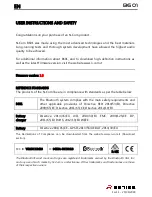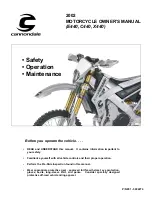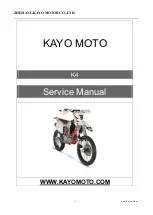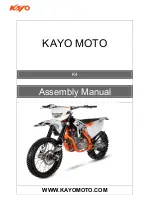
Chapter 1 – General information / Technical specifications
Service Manual AJP PR3/PR4 1 - 2
! DANGER !
The engine oil may cause skin cancer if left in
contact with the skin repeatedly for a long
period of time. Usually it is not necessary to
handle used oil every day, but it is
recommended that wash hands thoroughly
with soap and water after handling used motor
oil. KEEP USED OIL AWAY OF CHILDREN .
Brake dust
Never use compressed air or a dry brush to
clean the brakes.
! DANGER !
Asbestos fibers, if inhaled, can cause
respiratory diseases or cancer.
Brake fluid
Follow the guidelines of your country for
collecting and treatment of waste fluid. Never
dump into the sewer or ground.
! WARNING !
If the brake fluid is spilled on painted, plastic
or rubber parts can damage them. If a spill
occurs, immediately flush with water. Put a
cover on top of these painted pieces to protect
them when handling the brake circuit. KEEP
THE BRAKE FLUID AWAY OF CHILDREN.
Compressed nitrogen
Regarding to shock absorbers with gas
reservoir:
! DANGER !
Use only nitrogen to compression of the
shock absorbers. Using an unstable gas
may cause a fire or an explosion that can
lead to serious injury;
The shock absorbers containing nitrogen
under high pressure. Should never be near
a flame or heat source, since there are
explosion hazards that can lead to serious
injury;
Charging a damper with nitrogen carries a
risk of explosion which can lead to serious
injury if the damper is incorrectly heated or
bored.
To avoid risk of explosion, open the valve
mechanism and release nitrogen. The
remaining oil should be treated according to
the environmental legislation.
Before you discard a damper, open the valve
mechanism and release the nitrogen.
MAINTENANCE RULES
1. Use only components and lubricants
approved by AJP, or their equivalents.
Components that do not meet the
requirements of AJP can damage the
motorcycle.
2. Use only metric tools to perform
maintenance on the motorcycle. The
incorrect use of tools or attachments could
damage the motorcycle.
3. Always use O-rings, seals and gaskets for
new assembly.
4. When any part or component is attached
with several bolts (e.g. engine covers,
cylinder head, brake discs. sprocket, etc.)
begin tightening the inner screw largest
diameter, followed by pressing the opposite
diagonal, cross or X, gradually increasing
the torque to the specified value.
5. Clean the inside of the components with a
solvent after disassembly for inspection
and lubricate the friction surfaces before
proceeding to its assembly.
6. After installation, check that all parts are
installed correctly and working.



































